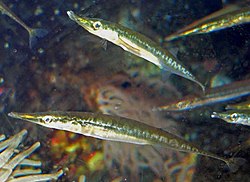![]() One of the most striking features of marine stickleback is the row of bony armor plates that run along the side of the body. These “armor plates” are actually enlarged and ossified lateral line scales, and they’re a unique feature of threespine stickleback; other sticklebacks (and tubesnouts) just have a tiny row of lateral scales at the most.
One of the most striking features of marine stickleback is the row of bony armor plates that run along the side of the body. These “armor plates” are actually enlarged and ossified lateral line scales, and they’re a unique feature of threespine stickleback; other sticklebacks (and tubesnouts) just have a tiny row of lateral scales at the most.
(illustration from Wikimedia Commons)
Freshwater stickleback populations will often have few to no armor plates, which has prompted biologists to look into the both the genetic basis of armor loss and the effect of natural selection on plate number.
In 1992, Canadian ecologist Tom Reimchen published a paper in Evolution that shed some light on the latter question.
Tom captured wild stickleback from a freshwater lake and then put them in an enclosure with one of their chief lake predators, the cutthroat trout. Predictably, the trout would bite the stickleback and try to eat it; whenever a bitten stickleback escaped or was spit out, Tom caught it. The first 153 fish were simply preserved, and the last 143 fish were placed in aquariums and monitored for several days to see if their injuries were fatal.
Then, Tom took a look at what sort of injuries all 296 stickleback had sustained from the trout attack. In particular, were stickleback with more armor plates injured less frequently than stickleback with fewer plates? It turned out that puncture wounds from trout teeth were significantly less common in more armored stickleback.

Top graph: plate number versus puncture wounds sustained
Bottom graph: plate number versus survival
In the second group of 143 fish that had been monitored for survival, over half of the fish died, many of whom did not survive the first 24 hours (for those wondering, Tom did have a control tanks of non-injured fish in the same room – they all survived). Fish with more plates survived significantly longer than fish with fewer plates; in addition, fish with injuries exhibited significantly lower survival.
Taken together, the results suggest that having more armor plates results in fewer injuries sustained from predators, which increases the fish’s chances of survival if it escapes being eaten.
There is one interesting caveat, though: all of these fish would still qualify as “low-plated” freshwater stickleback. Most of the plate variation involved the presence of a few additional plates closer to the head – does this mean that fully-plated marine fish get the same sort of protective benefit from having armor closer to the tail?
Reimchen, T. (1992). Injuries on Stickleback from Attacks by a Toothed Predator (Oncorhynchus) and Implications for the Evolution of Lateral Plates Evolution, 46 (4) DOI: 10.2307/2409768




Recent Comments